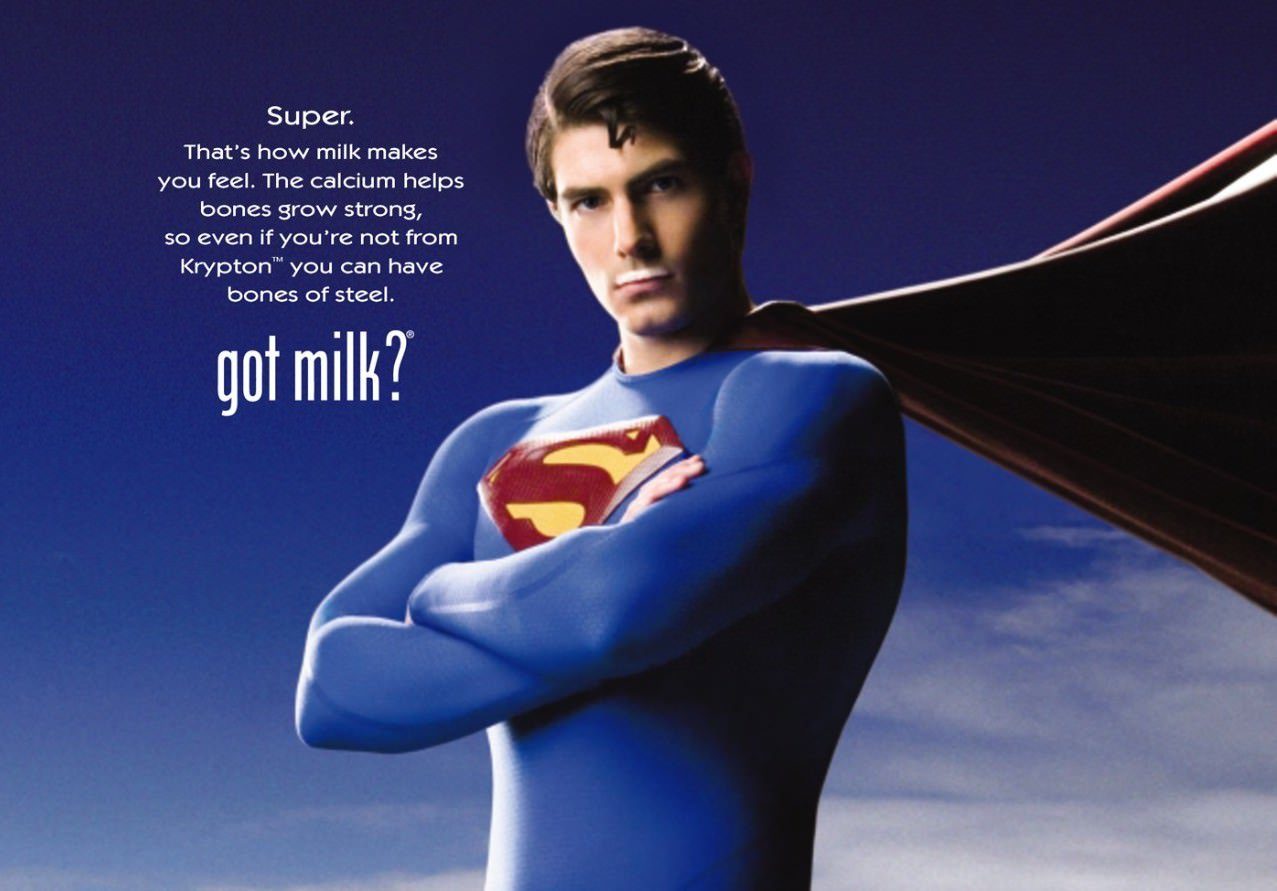Aside from the obvious reasons why we don't need cow's milk — no other animal drinks the milk from another species; we no longer need milk once weaned from our own mother's; and cow's milk is, well, meant for baby cows to grow into giant cows — we most certainly do not need dairy.
Got Milk?
This whole dairy façade began upon the premise that we need calcium, which we do, and that we can only get it through dairy products, which is false. There are a number of vegetables that contain even more calcium than milk, including broccoli, kale, cabbage, and watercress, along with a variety of nuts and seeds. But we never see ads on television telling us to eat our broccoli, even though it has many more health benefits than milk. Simply put, there is no lobbying behind broccoli.
Milk is heavily pushed into the mainstream media; of course we all remember those infamous Got Milk? advertisements which used celebrities to endorse milk and which portrayed drinking milk as being both cool and health conscious. And now they have gone even further with the new ad campaign funded by Canadian dairy farmers, Milk Every Moment, with a slogan that pulls on your heart strings: "Not everything made sense when you were a kid, but drinking milk did." They certainly know their business.
The following video created by Vox outlines the absurdity of milk quite nicely. Have a look!
Milk Simply Isn't Good For Us
I should be clear about this statement: conventional pasteurized milk is not good for us. The cattle used to create this milk are pumped full of hormones and antibiotics, all of which end up in the milk we are consuming — along with blood, puss, and fecal matter. The pasteurization process, moreover, destroys any beneficial enzymes within the milk. Not to mention that these dairy cows are virtually kept pregnant until retirement, without even having an opportunity for their calves to drink the milk that was made for them in the first place.
It's a horrific, backwards system. And while many people believe that raw, organic milk does offer many health benefits, it is actually illegal to sell this milk in Canada (go figure). Either way, I still don't think milk is a necessary staple; cow's milk is made for baby cows.
A large study coming from researchers at the Uppsala University in Sweden found that drinking milk led to an increased mortality rate and actually made bones more prone to fracturing, not less. Recently published in the peer reviewed British Medical Journal, it was specifically conducted to examine whether high milk consumption is associated with mortality and fractures in both men and women.
The study took place across three different counties in Sweden, and used data from two large Swedish cohorts, one with 61,433 women aged approximately 39-74 years old and one with 45,339 men aged approximately 45-79 years old. They were all administered food frequency questionnaires. The study used "multivariable survival models" that were "applied to determine the association between milk consumption and time to mortality and fracture.
The results were as follows:
During a mean follow-up of 20.1 years, 15 541 women died and 17 252 had a fracture, of whom 4259 had a hip fracture. In the male cohort with a mean follow-up of 11.2 years, 10 112 men died and 5066 had a fracture, with 1166 hip fracture cases. In women the adjusted mortality hazard ratio for three or more glasses of milk a day compared with less than one glass a day was 1.93 (95% confidence interval 1.80 to 2.06). For every glass of milk, the adjusted hazard ratio of all cause mortality was 1.15 (1.13 to 1.17) in women and 1.03 (1.01 to 1.04) in men. For every glass of milk in women no reduction was observed in fracture risk with higher milk consumption for any fracture (1.02, 1.00 to 1.04) or for hip fracture (1.09, 1.05 to 1.13). The corresponding adjusted hazard ratios in men were 1.01 (0.99 to 1.03) and 1.03 (0.99 to 1.07). In subsamples of two additional cohorts, one in males and one in females, a positive association was seen between milk intake and both urine 8-iso-PGF2α (a biomarker of oxidative stress) and serum interleukin 6 (a main inflammatory biomarker).The study concluded that high milk intake was associated with higher mortality in one cohort of women and in another cohort of men, and with higher fracture incidence in women, though it concluded that, "Given the observational study designs with the inherent possibility of residual confounding and reverse causation phenomena, a cautious interpretation of the results is recommended."
This is just one example; there have been countless other studies that reveal this same risk.
Okay I'll Give Up Milk, Now What?
You are not alone! The truth about milk is starting to come to light and many are opting for alternatives.
"U.S. milk consumption has been steadily declining by 25 percent per capita since the mid-1970s. Americans, on average, drink 37 percent less milk today than they did in 1970, according to data from the USDA," said Nil Zacharias, Co-Founder of One Green Planet, "On the other side, non-dairy milk sales are up 30 percent since 2011, representing a $2 billion category, and growth is expected to continue outpacing dairy milk sales at least through 2018. Consumers don't want milk anymore, and better alternatives are growing every day."
Almond, cashew, rice, hemp, soy, and pea-protein milks are all available to you at most grocery stores. The demand for these alternatives is increasing so more options are becoming available all the time. You can even, quite easily, make your own nut milks. Check out this recipe for a homemade almond milk, or this one for a homemade cashew and almond milk blend.
Let's just leave the cow's milk to go where it was intended: the baby cows!





Comment: Why you should stop drinking cow's milk